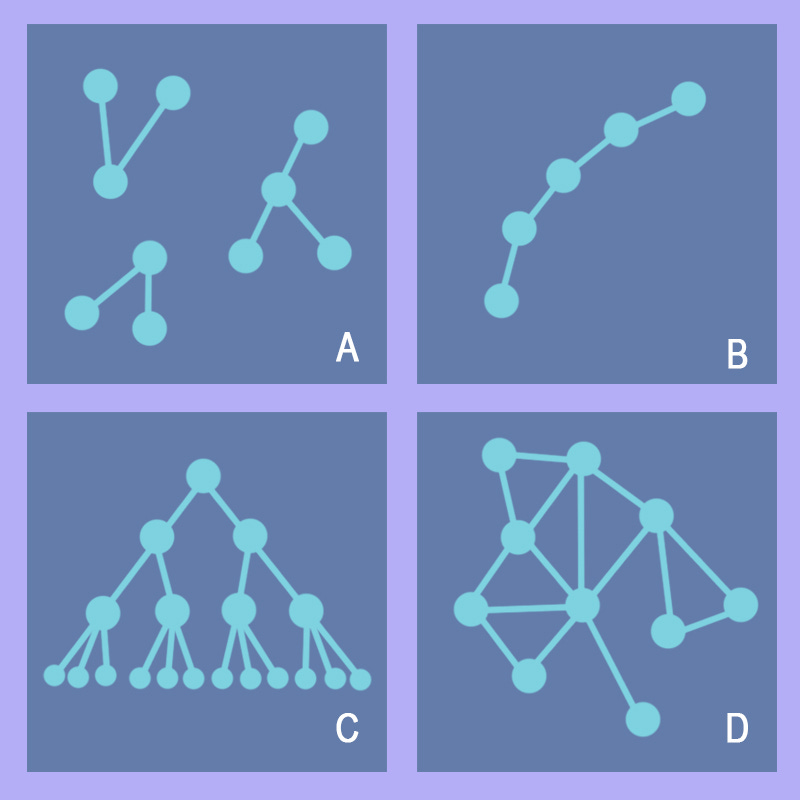In the last part, we discussed the organisation of knowledge with examples and its impact on learning. Today, we are going to talk about two kinds of knowledge organisations – expert and novice.
Experts’ knowledge organisation refers to the way experts organise the knowledge in their minds. Likewise, novices’ knowledge organisation refers to the way a novice or a person who is less experienced organises his or her ability. The two mainly differ in the number or density of connections among the facts, concepts or skills they know.
Let us take a look at the four following figures to understand a variety of knowledge organisations.
Figures A and B show the knowledge organisations of novices. The absence of links between nodes in figure A refers to the knowledge organisation of students who have not yet developed the ability to recognise the relationships among pieces of knowledge. This type of knowledge organisation happens when a student fails to connect themes that cut across an entire course or when the student fails to connect a lesson learned in one lecture to the other lectures. These disconnected pieces of knowledge may negatively impact a student’s learning in the future.
According to a study in 1982 conducted by Gary Lee Bradshaw, Professor at Mississippi State University, and John R. Anderson, Professor at Carnegie Mellon University, if a student lacks a strongly connected network, their knowledge will be slower and difficult to retrieve. This can also result in students failing to identify or rectify contradictions in their knowledge.
In figure B, knowledge connections are arranged in the form of a chain of associations but have lesser connections. Compared to figure A, this structure affords sequential access of information. For example, it could be helpful in tasks like remembering the stanzas of a poem or the steps of a procedure. However, problems arise when one link of the chain is broken, or a deviation is needed from the current structure. In this knowledge organisation, information is arranged in a simple chain, so it is more difficult to traverse from one piece of knowledge to the other. For example, imagine that a student arranges the events of World War I and World War II in a straight line. To retrieve information about a particular event, the student must try to remember each event in relation to the one before and the one after, resulting in a difficult memory task.
Complex and highly structured knowledge organisations allow experts to access and use their knowledge more efficiently.
Figures C and D show the knowledge organisations of experts. In figure C, knowledge is organised hierarchically. This indicates that the person who arranges knowledge this way understands how various pieces of information fit within a complex structure. However, not all data can be arranged in neat, hierarchical order. Therefore, figure D shows a more highly connected knowledge structure with additional links that indicate cross-referencing. It also suggests where hierarchies might break down.
Complex and highly structured knowledge organisations allow experts to access and use their knowledge more efficiently. Research has shown that experts automatically process information in coherent chunks based on their prior knowledge, and these chunks are used to build larger, interconnected knowledge structures.
Teachers, as subject matter experts, possess highly connected knowledge organisations. Problems may arise when they expect students who lack an analogous organisational structure to do the same. When students suddenly try to reciprocate the same, they will struggle because they try to remember a set of isolated facts without a proper organisational structure.
Research suggests that students can develop more sophisticated knowledge organisations over time. Research conducted by psychologists Gordon H. Bower, M.C. Clark, Alan Lesgold and David Winzenz suggests that students learn better when they are provided with a structure for organising information.
As teachers have highly developed organisational knowledge structures, it is not reasonable to expect students to have organised their knowledge that way. It is essential to recognise the differences in knowledge organisations between experts and novices and give feedback to students on how to manage knowledge and draw on it to perform tasks.
In the next part, we can discuss in detail the nature of connections in experts’ and novices’ knowledge organisations.
Thank you for listening. Subscribe to The Scando Review on thescandoreview.com.
Happy Teaching!














How knowledge organisations of experts and novices differ